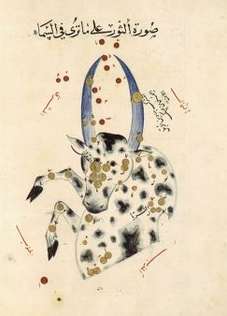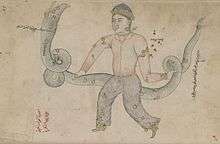Abd al-Rahman al-Sufi
| 'Abd al-Rahman al-Sufi | |
|---|---|
| Born |
7 December, 903 Rey, Buyid Persia |
| Died |
25 May, 986 (aged 83) Shiraz, Buyid Persia |
| Residence | Isfahan, Buyid Persia |
| Occupation | Astronomer |
| Era | Islamic Golden Age |
| Notable work | Book of Fixed Stars |
'Abd al-Rahman al-Sufi (Persian: عبدالرحمن صوفی (December 7, 903 in Rey, Iran – May 25, 986 in Shiraz, Iran) was a Persian[1][2][3] astronomer also known as 'Abd ar-Rahman as-Sufi, 'Abd al-Rahman Abu al-Husayn, 'Abdul Rahman Sufi, or 'Abdurrahman Sufi and, historically, in the West as Azophi and Azophi Arabus.[4] The lunar crater Azophi and the minor planet 12621 Alsufi are named after him. Al-Sufi published his famous Book of Fixed Stars in 964, describing much of his work, both in textual descriptions and pictures. Al-Biruni reports that his work on the ecliptic was carried out in Shiraz. He lived at the Buyid court in Isfahan.
Biography
'Abd al-Rahman al-Sufi was one of the famous nine Muslim astronomers. His name implies that he was from a Sufi Muslim background. He lived at the court of Emir Adud ad-Daula in Isfahan, Persia, and worked on translating and expanding Greek astronomical works, especially the Almagest of Ptolemy. He contributed several corrections to Ptolemy's star list and did his own brightness and magnitude estimates which frequently deviated from those in Ptolemy's work.
He was a major translator into Arabic of the Hellenistic astronomy that had been centered in Alexandria, Egypt, the first to attempt to relate the Greek with the traditional Arabic star names and constellations, which were completely unrelated and overlapped in complicated ways.
Astronomy

He identified the Large Magellanic Cloud, which is visible from Yemen, though not from Isfahan; it was not seen by Europeans until Magellan's voyage in the 16th century.[5][6] He also made the earliest recorded observation of the Andromeda Galaxy in 964 AD; describing it as a "small cloud".[7] These were the first galaxies other than the Milky Way to be observed from Earth.
He observed that the ecliptic plane is inclined with respect to the celestial equator and more accurately calculated the length of the tropical year. He observed and described the stars, their positions, their magnitudes and their colour, setting out his results constellation by constellation. For each constellation, he provided two drawings, one from the outside of a celestial globe, and the other from the inside (as seen from the earth).
Al-Sufi also wrote about the astrolabe, finding numerous additional uses for it: he described over 1000 different uses, in areas as diverse as astronomy, astrology, horoscopes, navigation, surveying, timekeeping, Qibla, Salat prayer, etc.[8]
Since 2006, Astronomy Society of Iran – Amateur Committee (ASIAC) hold an international Sufi Observing Competition in the memory of Al-Sufi. The first competition was held in 2006 in the north of Semnan Province[9] and the second was held in the summer of 2008 in Ladiz near the Zahedan. More than 100 attendees from Iran and Iraq participated in the event.[10]
Gallery
See also
References
- ↑ Al-Qifti. Ikhbar al-'ulama' bi-akhbar al-hukama ("History of Learned Men"). In: Άbdul-Ramān al-Şūfī and his Book of the Fixed Stars: A Journey of Re-discovery by Ihsan Hafez, Richard F. Stephenson, Wayne Orchiston (2011). In: Orchiston, Wayne, Highlighting the history of astronomy in the Asia-Pacific region: proceedings of the ICOA-6 conference. Astrophysics and Space Science Proceedings. New York: Springer. ISBN 978-1-4419-8161-5. "... is the honored, the perfect, the most intelligent and the friend of the King Adud al-Dawla Fanakhasru Shahenshah Ibn Buwaih. He is the author of the most honored books in the science of astronomy. He was originally from Nisa and is of a Persian descent."
- ↑ Robert Harry van Gent. Biography of al-Sūfī. "The Persian astronomer Abū al-Husayn ‘Abd al-Rahmān ibn ‘Umar al-Sūfī was born in Rayy (near Tehrān) on 7 December 903 [14 Muharram 291 H] and died in Baghdād on 25 May 986 [13 Muharram 376 H] ... the Persian astronomer Abū al-Husayn ‘Abd al-Rahmān ibn ‘Umar al-Sūfī who was commonly known by European astronomers as Azophi Arabus". University of Utrecht, Netherlands. Retrieved 2014-1-11
- ↑ Selin, Helaine (2008). Encyclopaedia of the history of science, technology, and medicine in non-western cultures. Berlin New York: Springer. p. 160. ISBN 9781402049606.
Al-Sūf ī was an astronomer in the Arabic–Islamic area. He was of Persian origin, but wrote in Arabic, the language of all science in that time.
- ↑ Robert Harry van Gent. Biography of al-Sūfī. "The Persian astronomer Abū al-Husayn ‘Abd al-Rahmān ibn ‘Umar al-Sūfī was born in Rayy (near Tehrān) on 7 December 903 [14 Muharram 291 H] and died in Baghdād on 25 May 986 [13 Muharram 376 H] ... the Persian astronomer Abū al-Husayn ‘Abd al-Rahmān ibn ‘Umar al-Sūfī who was commonly known by European astronomers as Azophi Arabus". University of Utrecht, Netherlands. Retrieved 2014-1-11
- ↑ "Observatoire de Paris (Abd-al-Rahman Al Sufi)". Archived from the original on 16 April 2007. Retrieved 2007-04-19.
- ↑ "Observatoire de Paris (LMC)". Archived from the original on 17 April 2007. Retrieved 2007-04-19.
- ↑ Kepple, George Robert; Glen W. Sanner (1998). The Night Sky Observer's Guide. 1. Willmann-Bell. p. 18. ISBN 0-943396-58-1.
- ↑ Dr. Emily Winterburn (National Maritime Museum) (2005). "Using an Astrolabe". Foundation for Science Technology and Civilisation. Retrieved 2008-01-22.
- ↑ http://www.asiac.ir/en/news/?NewsID=-333647997
- ↑ رقابت صوفي، درآمدي بر سال جهاني نجوم
External links
- Liber locis stellarum fixarum, 964 da www.atlascoelestis.com
- Liber locis stellarum fixarum, 964, manoscritto del 1417 riprodotto il 1730 da www.atlascoelestis.com
- Ulug Beg in www.atlascoelestis.com
- Al-Sufi's constellations
- Al-Sūfī’s Book of the Constellations of the Fixed Stars and its Influence on Islamic and Western Celestial Cartography





